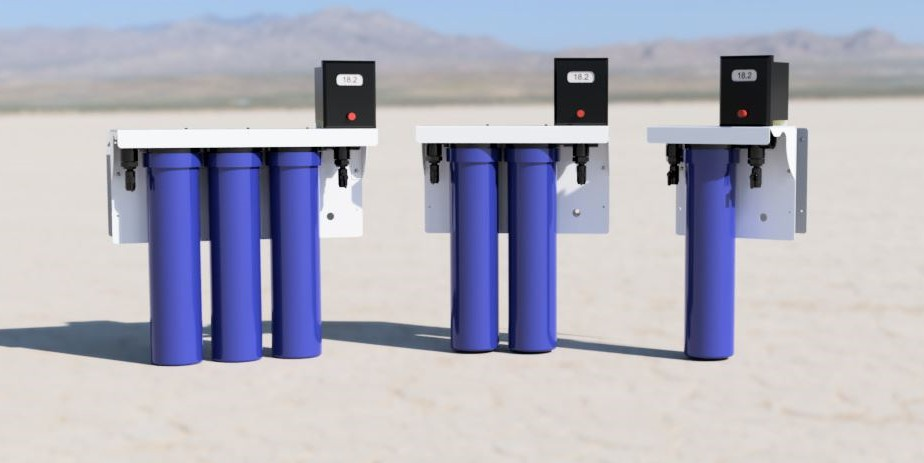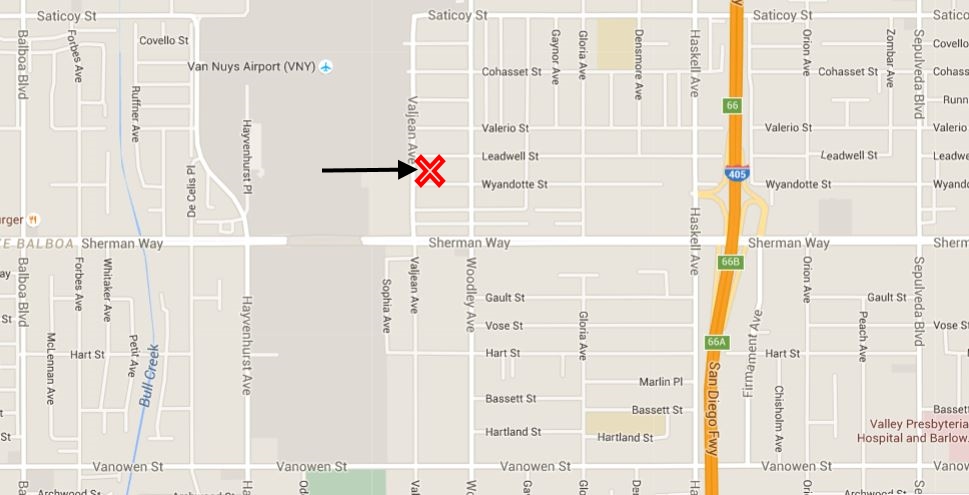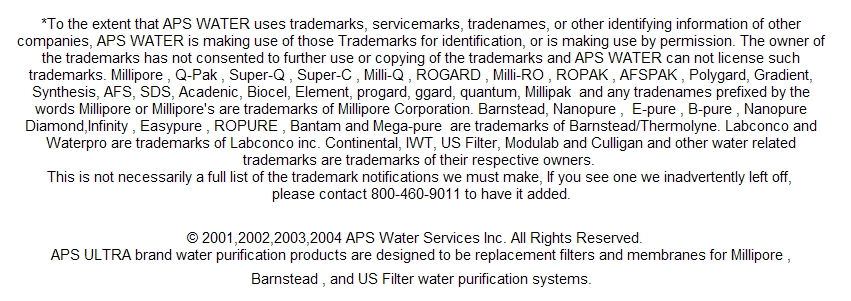|
Ultrapure-Water.com
Pure Water For Critical High Technology Applications |
An APSWATER Micro-Website™
A US Government Supplier DUNS 787700418 Rated "A+" with the BBB 33 years, Zero Complaints Click here to see our record |
 |
ON SALE NOW Introducing the Polaris Lab Water Systems High Purity Water Made In The USA. Click here for more info. |
Semiconductor Rinsewater Requirements
Specifications for electronic rinse water requirements are growing progressively and becoming more demanding as line widths that characterize silicon chip circuitry become finer and the electrical resistances required of their devices escalate. As time passes improvements in water purification have become more defined. Especially as newer more reliable measurement devices allow for better more reliable measurements and new means to improve water purity become available. High purity water quality specifications are often the limits of what is attainable at a given time. They do not totally reflect the bounds that are present, but rather they are the best levels currently possible and as a result must be tolerated. This is what is meant when using the term "state of the art." As time passes and progress occurs, specifications can be improved upon and they are. As a result there is a constant drive for ideal high purity water. However, in certain contexts its attainment is necessary to certain semiconductor devices and can impose an unnecessary expense and burden.
The American Society for Testing and Materials (ASTM) differentiates the purity of electronics grade water into four different types as shown in Table 1 below.
| Requirements for Electronic Grade Water Table 1 | ||||
| Type E-I | Type E-II | Type E-III | Type E-IV | |
| Resistivity Minimum megohm/cm at 25oC | Above 18 (95% of the time)Not less than 17.0 | 17.5 (90% of the time) not less than 16.0 | 12.0 | 0.5 |
| SiO2(total)maximum micrograms/L | 5 | 10 | 50 | 1,000 |
| Particle count per mL | 1 | 3 | 10 | 100 |
| Particle Size Limit | 0.10 microns | 0.5 microns | 1.0 microns | 10 microns |
| Viable Bacteria Maximum | 1/1000 mL | 10/1000 mL | 10/mL | 100/mL |
| Copper micrograms per liter (max) | 1 | 1 | 2 | 500 |
| Zinc micrograms per liter (max) | 0.5 | 1 | 5 | 500 |
| Nickel micrograms per liter (max) | 0.1 | 1 | 2 | 500 |
| Sodium micrograms per liter (max) | 0.5 | 1 | 5 | 1000 |
| Potassium micrograms per liter (max) | 2 | 2 | 5 | 500 |
| Chloride micrograms per liter (max) | 1 | 1 | 10 | 1000 |
| Nitrate micrograms per liter (max) | 1 | 1 | 5 | 500 |
| Phosphate micrograms per liter (max) | 1 | 1 | 5 | 500 |
| Sulfate micrograms per liter (max) | 1 | 1 | 5 | 500 |
| Total organic Carbon micrograms /L | 25 | 50 | 300 | 1000 |
| Endotoxins | 0.03 EU | 0.25 EU | N/A | N/A |
It should be noted that as the line widths become become thinner the specific numbers and sizes of the particles become smaller. Also, live bacteria which is a special type of particles due to their replicating power are meeting with increasingly restrictive specifications. Along with the concern for particles is a circumscription of the already meager tolerance accorded lower electrical resistivities. So, while an E-IV water may exhibit a resistivity value of of 0.5 microsiemens-cm at 25oC, the E-I water must not have a electrical resistivity below 17 microsiemens-cm and should have a resistivity value of aboce 18 microsiemens-cm 95% of the time.
Of all the listed cation impurities, electronics grade water defined y ASTM call for decreases of potassium from 5 micrograms per liter to 2 micrograms er liter for the E-IV to E-I types. Sodium goes from 2 micrograms per liter to 0.5 ,micrograms per liter, zinc from 5 micrograms per liter to 0.5 micrograms per liter and lastly nickel from 2 micrograms per liter to 0.1 micrograms per liter.
Analytical lab specifications as it relates to the line widths of semiconductordevices and the particle sizes and numbers appropriate to them can be seen in Table 2 below.
(Organics should be regulated pre and post UV; breakdown by UV may yield ionic species such as Cl -, Br-.)
| Critical Specifications for High-Purity Water Table 2 | ||||
|---|---|---|---|---|
| MOS | 0.8 Microns | 0.5 Microns | 0.3 Microns | |
| Particles/liter of sizes less than | 0.3 | 0.08 | ? 0.05 |
? 0.03 |
| Bacteria/100mL (living & dead) FF POU |
0 0 0 |
|||
| Organics, ppb TOC FF POU |
||||
| Purgeables FF & POU |
||||
| Extractables FF & POU |
||||
| SiO2 Requires resin regulation by SiO2; (by BO2-) |
||||
| Resistivity | >17.5 | 18.2 | 18.2 | 18.2 |
| Metal Ions Total Per Metal |
? ? |
Anions Total Per anion |
||
(Organics should be regulated pre and post UV; breakdown by UV may yield ionic species such as Cl -, Br-.)Line widths of 0.8 microns and (Metal Oxide Subtrate: metal nano material) MOS-1=2 are specified at less than 500 per liter of sizes 0.08 microns and 0.3 microns respectively. Line widths of 0.5 microns and 0.3 microns even though there are no numbers specified their sizes are to be less than 0.05 microns and 0.3 microns respectively. For lines of 0.3 microns, bacteria living and dead are to be a total of zero both at filters and points of use. The 0.5 micron line width allows for fewer than 2 per 100 mL at the points of use, but none at the final filters. For MOS 1=2 widths have slightly higher counts but are less than 10 per 100 mL. The number of living and dead bacteria stipulated for the 0.8 micron line width is less than 3 per 100 mL at the final filter and less than 10 at the point of use.
Laboratory specifications limit the organic concentrations at both the final filters and point of use to less than 20 ppb for MOS 1=2, dropping to less than 1 ppb for the 0.3 Micrometer width. For silica concentrations in the range MOS 1=2 at 8 micrometers, 0.5 micrometers and 0.3 micrometers are specified to be below 3 ppb, 0.5 ppb, 0.1 ppb and 0.05 ppb respectively.
In regards to water testing, critical testing is not limited to just particles, but to all water testing. This includes tests such as EPI bacteria counting for living and dead bacteria, measuring ions in solutions both metallic and non metallic even down to the ppt levels and measuring as well identifying organics at less than the 10 ppb range. Critical testing should not be limited just final filter and point of use. There are new tests that are beginning to reveal the use of critical testing that is useful for following wafer cleanliness. The required quality standards for pure water is way beyond present testing capabilities. New procedures are being developed. This is occurring because there is more cooperation between vendors, process engineers, facility personnel and the analytical laboratory.
High purity semiconductor-grade water should routinely monitored for bacteria, TOC, resistivity, silica, particulates, trace ions, and residual solids. The system should be inspected weekly at makeup, polishing, and point of use stations. In order to see how stringent the standards have and continue to become over time for electronic rinsewater see Table 3 below that shows comparisons for 1975, 1980, and 1985.
| Pure Water Specifications* Table 3 | |||||
|---|---|---|---|---|---|
| Test | 1975 | 1980 | 1985 Acceptable | 1985 Attainable | |
| Residue-ppm | 0.5 | 0.3 | 0.1 | ||
| TOC ppb | 200 | 100 | |||
| Particulates/L** | 4,000 | 1,000 | <1,000 | ||
| Bacteria/100mL | 20 | 0 | |||
| Dissolved SiO2 - ppb | 5 | <3*** | |||
| Resistivity*** | 16.0 | 17.0 | 17.9 | 18.3 | |
| Ionic Concentration - ppb | |||||
| Cations | |||||
| Na | - | - | 0.2 | 0.05 | |
| K | - | - | 0.3 | 0.1 | |
| NH4 | - | - | 0.3 | ||
| Zn | - | - | 0.1 | 0.02 | |
| Fe | - | - | 0.1 | 0.02 | |
| Cu | - | - | 0.1 | 0.02 | |
| Cr | - | - | 0.1 | 0.02 | |
| Mn | - | - | 0.5 | 0.05 | |
| Al | - | - | 2.0 | 0.2 | |
Anions |
|||||
| Cl | - | - | 0.2 | 0.05 | |
| Br | - | - | 0.1 | ||
| NO2 | - | - | 0.1 | 0.05 | |
| NO3 | - | - | 0.1 | ||
| PO4 | - | - | 0.2 | ||
| SO4 | - | - | 0.3 | 0.05 | |
| *These specifications shown are based on the quality of the final filter water found throughout the United States in companies that manufacture integrated circuitry. When possible measurements were checked against known standards. It should be noted that many of the numbers listed are relative to the testing method and to the standardization or calibration of the techniques used. **In Line - In Line samples specifications are counted at 100x. All counts are subjective and should only be viewed as relatively comparable. *** Inline resistivity measurements should be at 18 megohm-cm 90% of the time with a 17 megohm-cm minimum. |
|||||
In 1985 the bacterial level that could be achieved was said to be zero per 100 ml. At the time fewer than 6 cfu/100 ml was considered acceptable. In 1975 and 1980 the bacterial levels that were acceptable were 20 cfu/100 ml and fewer than 20 cfu/100 ml respectively. Using Table 4 this information can compared to that of the SEMI (Semiconductor Equipment Manufacturing Institute) recommended bacteria levels for fewer than 6 bacteria per 100 mL in 1985.
| SEMI Pure Water Guidelines 1985 Table 4 | |||||
|---|---|---|---|---|---|
| Test | Attainable | Acceptable | Alert | Critical | |
| Residue (ppm) | 0.1 | >0.3>0.5 | |||
| TOC ppb | >100>400 | ||||
| Particulates/L* | <1,000>2,500>5,000 | ||||
| Bacteria/100mL | 0 | >10>50 | |||
| Dissolved SiO2 - ppb | <3** | >10>40 | |||
| Resistivity*** | 18.3 | 17.9 | 17.5 | 17 | |
| Ionic Concentration - ppb | |||||
| Cations | |||||
| Na | 0.05 | 0.2 | 1.0 | 5.0 | |
| K | 0.10 | 0.3 | 1.0 | 4.0 | |
| NH4 | 0.30 | 0.3 | 0.5 | - | |
| Zn | 0.02 | 0.1 | 0.5 | - | |
| Fe | 0.02 | 0.1 | 0.2 | - | |
| Cu | 0.02 | 0.1 | 0.5 | - | |
| Cr | 0.02 | 0.1 | 0.5 | - | |
| Mn | 0.05 | 0.5 | 1.0 | - | |
| Al | 0.20 | 2.0 | 5.0 | - | |
Anions |
|||||
| Cl | 0.05 | 0.2 | 0.8 | - | |
| Br | 0.20.8- | ||||
| NO2 | 0.05 | 0.1 | 0.3 | - | |
| NO3 | 0.10.5- | ||||
| PO4 | 0.20.3- | ||||
| SO4 | 0.05 | 0.3 | 1.0 | - | |
| *In Line - In Line samples specifications are counted at 100x. All counts are subjective and should only be viewed as relatively comparable. **Detection Limit *** Inline resistivity measurements should be at 18 megohm-cm 90% of the time with a 17 megohm-cm minimum. |
|||||
It is of interest to note that Table 5 shows the quality of the high purity water produced by three systems at Tohoku University in Japan in 1991. This resulted in new suggestions for an updated version of high-purity water needed for the semiconductor industry as seen in Table 6. These suggestions can be compared with the requirements for high-purity water set forth at the time in Table 7. Notice that the requirements suggested Table 6 are slightly more stringent.
| 1991 High Purity Water in Mini-Superclean Room Tohoko University Table 5 | ||||
|---|---|---|---|---|
| System 1 | System 2 | System 3 | ||
| Resistivity (MΩ-cm) | 18.25 | 18.25 | 18.25 | |
| TOC (μg/L) | ||||
| SiO2 (μg/L) | ||||
| Dissolved Oxygen(μg/L) | 3~5 | 6~10 | ||
| Total Residue(μg/L) | ||||
| Particles (counts/mL) >.07μm |
1~2 |
1~2 |
0~1 |
|
| 1991 Suggested Transition Requirement for Ultrapure Water Table 6 | ||||||
|---|---|---|---|---|---|---|
| Integrate (bit) | 256k | 1M | 4M | 16M | Measurement Method | |
| Design Rule (μm) | 1.5-2.0 | 1.0-1.2 | 0.8 | 0.5 | ||
| Resistivity (MΩ/cm) 25oC |
17 - 18< | 17.5 - 18< | 18.0< | 18.1< | Specific Meter Resistance | |
| Paticle Size (μm) |
0.2 - 0.1 |
0.1 |
0.1 - 0.08 |
0.05 |
SEM Method | |
| Number (PCS/ml) | 30-50 - 50> | 20> - 10> | 10> - 5> | 10> | ||
| Live Bacteria (CFU/ml) | 0.2> - 0.05> | 0.05> - 0.01> | 0.05> - 0.01> | 0.01> - 0.005 | M-TEG | |
| TOC (μg/l) | 100> - 50> | 50> - 30> | 30> - 10> | 10< - 5> | Wet Oxidation Method TOC | |
| Dissolved Oxygen (μg/l) | 100> | 100> - 50> | 50> | 50> - 10> | Dissolved Oxygen Meter | |
| Silica (μg SiO2/l) | 10> | 10> - 5> | 5> - 3> | 1> | Ion Chromatography | |
| 1991 Water Quality Requirements for High Purity Water Table 7 | ||||||
|---|---|---|---|---|---|---|
| Integrate (bit) | 256k | 1M | 4M | 16M | Measurement Method | |
| Design Rule (μm) | 1.5~2.0 | 1.0~1.2 | 0.8 | 0.6 | ||
| Resistivity (MΩ/cm) 25oC |
>18 | >18 | >18 | >18.1 | Specific Meter Resistance | |
| Fine Particles Diameter (μm) |
0.1 |
0.1 |
0.1 |
0.05 |
SEM Method |
|
| Fine Particles Number (number/mL) |
SEM Method |
|||||
| Live Bacillus (number/mL) |
M-TGE Culture Method |
|||||
| TOC (μg/L) | Wet Oxidation TOC Meter | |||||
| Dissolved Oxygen Meter (μg/L) |
Dissolved Oxygen Meter |
|||||
| SiO2 (μg/L) | Ion Chromatograph | |||||
| Cr (μg/L) | - | - | Ion Chromatograph | |||
| Fe (μg/L) | Ion Chromatograph | |||||
| Mn (μg/L) | - | - | Ion Chromatograph | |||
| Zn (μg/L) | - | - | Ion Chromatograph | |||
| Cu (μg/L) | Ion Chromatograph | |||||
| Na (μg/L) | Ion Chromatograph | |||||
| K (μg/L) | - | - | Ion Chromatograph | |||
| Cl (μg/L) | Ion Chromatograph | |||||
It is evident that when comparing the tables that the trend towards ever lower impurities in water at all levels it evident. As means to measure specific impurities becomes more reliable and as methods of control and removal become more efficient the maximum levels for the presence of these impurities will continue to decrease. No matter if driven by advances in attainability or out of applicational necessity the quest for pure semiconductor rinsewaters will continue as the technology for ultrapure water grows and as technology as a whole grows.
 |

Don't want Paypal?
Click here to use our main site
APSWATER.com
for all other options
Purchase Orders Accepted
(subject to approval)
Credit Application
Jump To Our Main Site
|
Menu
Home About Us Tech Articles Products |

Contact Us
818-786-0600
800-460-9011 Toll Free
818-786-2347 Fax
E-Mail Us

Get Travel Directions

All Images are representative and may or may not be of actual product.
ULTRAPURE-WATER.COM content (C)2009-2024 APS Water Services Corporation - All rights reserved
Website Software - Multi-Website Content Manager - Wilson Web Engineering (C)2012-2024
Micro-Website is a trademark of Wilson Web Engineering
semiconductor rinsewater requirements
4/26/2024
6:45:58 AM

| Other APS Web Properties | Barnstead-Water.com | lab-Water-filters.com | lab-water System.com | LabFilter.com | Millipore-alternative.com | Durastill Water DIstillers.com |